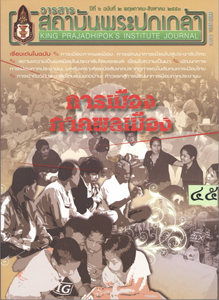การบริหารการเปลี่ยนแปลงองค์การ : มุมมองแนวบูรณาการกระบวนการและพฤติกรรม
Main Article Content
Abstract
ประวัติศาสตร์ขององค์การและการจัดการสมัยใหม่สะท้อนให้เห็นความผูกพันระหว่างองค์การและการเปลี่ยนแปลงมาโดยตลอด กล่าวคือ นับตั้งแต่เฟรดเดอร์ริค เทเลอร์ได้ประดิษฐ์คิดค้นและนาเสนอหลักการการจัดการเชิงวิทยาศาสตร์ (Scientific Management) เพื่อเป็นรากฐานและหลักการบริหารองค์การ หลักการจัดการเชิงวิทยาศาสตร์ทาให้เกิดการปฏิวัติทั้งในด้านรูปแบบความคิดและแนวการปฏิบัติของการบริหารองค์การ ในด้านหนึ่ง ลัทธิเทเลอร์ได้สร้างคุณูปการในการพัฒนาอุตสาหกรรมอย่างมากมาย โดยเฉพาะการเพิ่มประสิทธิภาพการผลิตและผลผลิตของโรงงาน แต่ในอีกด้านหนึ่งลัทธิเทเลอร์ได้รับคาวิพากย์วิจารณ์ว่าทาให้องค์การในภาพรวมและงานในองค์การเปลี่ยนสภาพเป็นลักษณะ “ กดขี่มนุษย์” (dehumanized) ในยุคถัดมา เฮนรี ฟอร์ด ได้ประดิษฐ์สายการผลิตแบบเคลื่อนที่ (moving assembly line) สาหรับองค์การอุตสาหกรรม ซึ่งมีผลทาให้สามารถลดเวลาการผลิต สร้างมาตรฐานผลผลิต และเพิ่มประสิทธิภาพผลผลิตได้อย่างมหาศาล จนถึงอีกยุคหนึ่งซึ่งมีการสร้างองค์การให้มีลักษณะสมบูรณ์มากขึ้น ทั้งในด้านการจัดรูปแบบองค์การให้มีความสอดคล้องกับสภาพแวดล้อมของอุตสาหกรรมและการนาเสนอหลักการบริหารสมัยใหม่เพื่อเพิ่มประสิทธิภาพ (efficiency) และประสิทธิผล (effectiveness) ขององค์การ ภายใต้บริบทการขยายตัวของขอบเขตอุตสาหกรรมและการแข่งขันที่มีความรุนแรงและเข้มข้นมากขึ้น พื้นฐานดังกล่าวนาไปสู่การศึกษาค้นคว้าเพื่อให้ได้แนวความคิดและทฤษฎี หลักการและรูปแบบ กระบวนการและเทคนิคต่างๆเกี่ยวกับองค์การและการจัดการที่มีความเหมาะสมและสอดคล้องกับสภาพการณ์ที่เป็นจริงในแต่ละยุคสมัย
ในปัจจุบัน ความสนใจและการศึกษาเกี่ยวกับการเปลี่ยนแปลงองค์การ (organizational change) มีความหลากหลายทั้งในด้านหลักการพื้นฐาน มุมมอง และระเบียบวิธีการ การศึกษาแนวนวัตกรรมองค์การ (organizational renewal) ซึ่งอยู่ภายใต้อิทธิพลแนวคิดนิเวศย์วิทยาประชาการ (population ecology) เน้นการปรับเปลี่ยนรูปแบบองค์การคล้อยตามการเปลี่ยนแปลงของสิ่งแวดล้อม การศึกษาการพัฒนาองค์การแนวดั้งเดิม (Traditional OD) ซึ่งได้รับอิทธิพลความคิดการเปลี่ยนแปลงตามแผน (planned change) มุ่งการประยุกต์ใช้พฤติกรรมศาสตร์เพื่อบาบัดรักษาสุขภาพ (therapy) และปรับองค์การให้มีประสิทธิผล และการศึกษาการพัฒนาองค์การแนวใหม่ (organizational transformation) เน้นการเปลี่ยนสภาพองค์การให้มีความสามารถเรียนรู้และปรับตัวไปสู่คุณภาพใหม่ที่ตอบสนองความต้องการของคนและองค์การ ผลที่ตามมาคือมีการนาเสนอการเปลี่ยนแปลงองค์การหลากหลายจุดมุ่งหมายและรูปแบบ การเลือกใช้รูปแบบการเปลี่ยนแปลงให้เหมาะกับโลกความจริงจึงยากลาบากมากขึ้น
บทความนี้มีจุดมุ่งหมายหลัก 3 ประการคือ ประการแรกเพื่อทบทวนพื้นฐานความรู้เกี่ยวกับแนวคิดและรูปแบบข้อเสนอของการเปลี่ยนแปลงองค์การ ประการที่สองคือการเสนอกรอบวิเคราะห์การเปลี่ยนแปลงองค์การที่เน้นการบูรณาการระหว่างกระบวนการเปลี่ยนแปลง (change process) และพฤติกรรมองค์การ (organizational behavior) และประการสุดท้ายคือการเสนอแนะแนวบรรทัดฐาน (normative guides) ที่สนับสนุนให้เกิดการเปลี่ยนแปลงในแต่ละขั้นตอน
Article Details
@ 2020 King Prajadhipok's Institute The Government Complex Commemorating All Right Reserved.
References
2. Beer, M. and R.A. Eisenstat. 1996. “Developing an Organization Capable of Implementing Strategies and Learning. “ Human Relations, 49,5: 597-619.
3. Bennis, W. and B. Nanus. 1997. Leaders: Strategies for Taking Charge. N.Y.: Harper
4. Burke, W.W. 1995. “ Organizational Change: What We Know, What We Need to Know.” Journal of Management Inquiry, 4,2: 158-71.
5. Carr, D.K., K.J. Hard and W.J. Trahant. 1996. Managing the Change Process. N.Y.: McGraw-Hill.
6. Cumming, T.G. and C.G. Worley, eds. 2005. Organization Development and Change, 8th ed. Thomson South-Western.
7. French, W.L., C.H. Bell, jr. and R.A. Zawacki. 2005. Organization Development and Transformation: Managing Effective Change, 6th ed. New York: McGraw-Hill.
8. Ghoshal, S. and C.A. Bartlett. 1996. “ Rebuilding Behavioral Context: A Blueprint for Corporate Renewal “ Sloan Management Review 37, 2: 23-36.
9. Hall, R.H. 1996. Organizations: Structured, Processes and Outcomes, 6th ed. Englewood Cliffs, NJ: Prentice-Hall.
10. Hammer, M. and S.A. Stanton. 1995. The reengineering Revolution. N.Y.: Harper.
11. Hendry, C. 1996. “ Understanding and Creating Whole Organizational Change Through Learning Theory.” Human Relations 49,5: 621-41.
12. Huber, G.P. and W.H. Glick. 1995. Organizational Change and Redesign: Ideas and Insights for Improving Performance. N.Y.: Oxford University Press.
13. Jick, T.D. 1995. “ Accelerating Change for Competitive Advantage.” Organizational Dynamics, 24,1: 77-82.
14. Kanter, R.M. 1983. The Change Masters. N.Y.: Simon and Schuster, Inc.
15. Kelman, S. 2005. Unleashing Change: A Study of Organizational Renewal in Government. Washington, D.C.: Brooking Institution Press.
16. Kotter, J.P. 1996. Leading Change. Boston, MA: Harvard Business School Press
17. Lee, W.W. and K.J. Krayer. 2003. Organizing Change. San Francisco, CA: Pfeiffer.
18. Mabey, C. and Mayon-White, B., ed.1993. Managing Change. London: Pual Chapman Publishing Ltd.
19. Marshak, R.J. 1993. “ Lewin Meets Confucius: A Re-view of the OD Model of Change.” Journal of Applied Behavioral Science, 24, 4: 393-415.
20. Miller, et.al. 1997. “ Creative Chaos versus Munificent Momentum: the Schism between Normative and Academic Views of Organizational Change.” Journal of Management Inquiry, 6,1: 71-78.
21. Palmer, I. and C. Hardy. 2000. Thinking about Management. London: Sage Publications.
22. Pettrigrew, A. 1985. The Awakening Giant. Oxford, UK: Basil Blackwell.
23. Rogers, E.M. 1995. The Diffusion of Innovation, 4th ed. N.Y.: Free Press
24. Senge, P.M. 1990. The Fifth Discipline: The Art and Practice of the Learning
Organization. N.Y.: Doubleday.
25. Smith,R. 1997. The Seven Levels of Change: Create, Innovate and Motivate with the Secrets of the World’s Largest Companies. Arlington, TX: Summit Publishing Group.
26. Weick, K. 1984. The Social Psychology of Organizing. Reading, MA: Addison-Wesley.
27. Wind, J.Y. and J. Main. 1998. Driving Change: How the Best Companies Are Prepared for the 21st Century. N.Y.: The Free Press.

